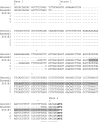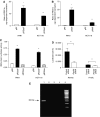A gastrin transcript expressed in gastrointestinal cancer cells contains an internal ribosome entry site
- PMID: 18392051
- PMCID: PMC2391123
- DOI: 10.1038/sj.bjc.6604326
A gastrin transcript expressed in gastrointestinal cancer cells contains an internal ribosome entry site
Abstract
As the hormone gastrin promotes gastrointestinal (GI) cancer progression by triggering survival pathways, regulation of gastrin expression at the translational level was explored. Sequence within the 5' untranslated region of a gastrin transcript expressed in GI cancer cells was investigated, then cloned into a bicistronic vector upstream of firefly luciferase and transfected into a series of GI cancer cell lines. Firefly luciferase activity was measured relative to that of a cap-dependent Renilla luciferase. A gastrin transcript that was different from that described in Ensembl was expressed in GI cancer cells. Its transcription appears to be initiated within the region designated as the gene's first intron. In GI cancer cells transfected with the bicistronic construct, firefly luciferase activity increased 8-15-fold compared with the control vector, and there was a further induction of the signal (up to 25-fold) following exposure of the cells to genotoxic stress or hypoxia, suggesting that the sequence acts as an internal ribosome entry site. These data suggest that the gastrin transcript within GI cancer cells contains an internal ribosome entry site that may allow continued expression of gastrin peptides when normal translational mechanisms are inactive, such as in hypoxia, thereby promoting cancer cell survival.
Figures




Similar articles
-
Analysis of full length ADAMTS6 transcript reveals alternative splicing and a role for the 5' untranslated region in translational control.Gene. 2005 Oct 10;359:99-110. doi: 10.1016/j.gene.2005.06.011. Gene. 2005. PMID: 16129570
-
Connexin43 mRNA contains a functional internal ribosome entry site.FEBS Lett. 1999 Dec 31;464(3):118-22. doi: 10.1016/s0014-5793(99)01699-3. FEBS Lett. 1999. PMID: 10618489
-
Kaposi's sarcoma-associated herpesvirus vCyclin open reading frame contains an internal ribosome entry site.J Virol. 2001 Feb;75(4):1864-9. doi: 10.1128/JVI.75.4.1864-1869.2001. J Virol. 2001. PMID: 11160685 Free PMC article.
-
Two haplotypes of 5' untranslated region in L-myc gene with different internal ribosome entry site activity.Int J Oncol. 2005 Jan;26(1):287-93. Int J Oncol. 2005. PMID: 15586251
-
Use of interfering RNA to investigate the role of endogenous gastrin in the survival of gastrointestinal cancer cells.Br J Cancer. 2007 Feb 12;96(3):464-73. doi: 10.1038/sj.bjc.6603588. Epub 2007 Jan 30. Br J Cancer. 2007. PMID: 17262081 Free PMC article.
Cited by
-
Induction of gastrin expression in gastrointestinal cells by hypoxia or cobalt is independent of hypoxia-inducible factor (HIF).Endocrinology. 2012 Jul;153(7):3006-16. doi: 10.1210/en.2011-2069. Epub 2012 May 16. Endocrinology. 2012. PMID: 22593272 Free PMC article.
-
Risk factors and therapeutic targets in pancreatic cancer.Front Oncol. 2013 Nov 18;3:282. doi: 10.3389/fonc.2013.00282. Front Oncol. 2013. PMID: 24303367 Free PMC article. Review.
References
-
- Beales IL (2004) Gastrin and interleukin-1beta stimulate growth factor secretion from cultured rabbit gastric parietal cells. Life Sci 75: 2983–2995 - PubMed
-
- Bushell M, Stoneley M, Sarnow P, Willis AE (2004) Translation inhibition during the induction of apoptosis: RNA or protein degradation? Biochem Soc Trans 32: 606–610 - PubMed
-
- Clarke PA, Dickson JH, Harris JC, Grabowska A, Watson SA (2006) Gastrin enhances the angiogenic potential of endothelial cells via modulation of heparin-binding epidermal-like growth factor. Cancer Res 66: 3504–3512 - PubMed
-
- Coldwell MJ, deSchoolmeester ML, Fraser GA, Pickering BM, Packham G, Willis AE (2001) The p36 isoform of BAG-1 is translated by internal ribosome entry following heat shock. Oncogene 20: 4095–4100 - PubMed
-
- Coldwell MJ, Mitchell SA, Stoneley M, MacFarlane M, Willis AE (2000) Initiation of Apaf-1 translation by internal ribosome entry. Oncogene 19: 899–905 - PubMed
Publication types
MeSH terms
Substances
LinkOut - more resources
Full Text Sources
Research Materials
Miscellaneous

